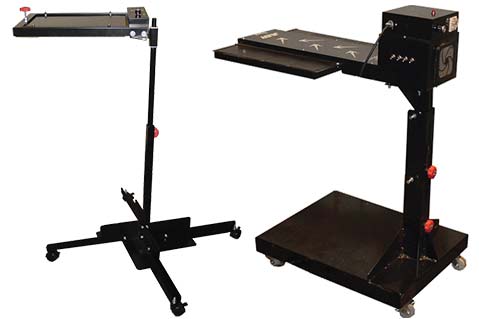Product Hub March 24, 2017
Which Flash Cure Unit is Right for Your Shop
The right flash-cure unit can help white inks pop and specialty inks shine.
Maintenance is about keeping machines in ideal condition, but it’s also about making sure your equipment meets your shop’s needs. A machine with the right capacity will save time and money, as it won’t have to be jury-rigged or coaxed to do what is needed. Consider flash-cure units and how they integrate with the screen-print process. The technology, sizing, features and price tag vary, so finding a unit that fits with a shop’s budget and processes is key. Let’s examine a few options.

First up is the cal-rod or firebrick-style flash-cure unit, which should be familiar to many shops. These units have a heat source that stays hot all the time. They’re durable and reliable, though they generally have limited features and controls. You can adjust temperature by shifting the distance of the unit from the garment and varying heating time. Some units have motorized heads that rotate the heater on and off the platen at a set interval, reducing the possibility of scorching a garment and enabling a more consistent gelling of the ink. Cal-rod units are the least expensive and tend to last for years, allowing shops to recoup investment costs.
A quartz flash unit, your next option, was originally designed to be mounted on an automatic T-shirt press. These units are instant on/off and react quickly when the temperature is adjusted. A quartz unit typically comes with temperature controls, and how hot the units get depends on the number of bulbs and how tightly they’re mounted. The more bulbs packed into a smaller space, the hotter the unit, but also the higher the power consumption. Quartz units cost at least three times more than cal-rod units. However, they’re often worth the price, because they’re generally hotter and faster, producing more reliable results. For shops that print higher volumes or focus on temperature-sensitive garments, quartz units are a good investment.
There are also specialty flash units. Some companies offer flat heaters that mount onto an automatic press. These heaters are encased in Teflon with a roller that presses onto a print. Flat heaters can be precisely controlled and react quickly to temperature adjustments. They produce crisp prints that the fashion market desires, and share a similar price tag with quartz units.
The Bottom Line
When you choose a flash-cure unit, think about production speed, power availability and consumption costs, finished look requirements and temperature adjustment requirements. The best machine is one that meets the most criteria without breaking the budget. The right machine also helps to reduce maintenance costs, as it won’t require constant tinkering to meet the necessary workload.
Read This!
Check out this blog post from Brown Manufacturing to learn how screen-printing shops can lower their power bills by choosing the right flash cure unit.

Product Hub
Find the latest in quality products, must-know trends and fresh ideas for upcoming end-buyer campaigns.
